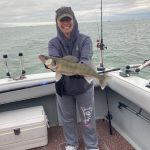DNR reminds anglers of lake sturgeon fishing regulations and rehabilitation efforts
As spring arrives, anglers fishing in our rivers may unexpectedly find themselves with a lake sturgeon on the line. The Michigan Department of Natural Resources reminds anglers that special regulations exist for lake sturgeon, and fishing for lake sturgeon is prohibited except in a few locations in the state.
Can anglers fish for lake sturgeon?
In the Lower Peninsula, lake sturgeon may be encountered in places such as Manistee Lake, the Manistee River, Muskegon Lake, the Muskegon River, the Grand River, the Kalamazoo River, and Saginaw Bay and its tributaries, but it is unlawful to fish for lake sturgeon in these waters; any lake sturgeon incidentally caught while targeting other species must immediately be released. Additionally:
- Never hold a sturgeon in a vertical position by its head, gill covers or tail.
- Never touch the fish’s eyes or gills.
- Handle the fish as little as possible.
Waters with sturgeon possession seasons include Lake St. Clair and the St. Clair River, Otsego Lake, the Menominee River and Black Lake. Waters with sturgeon fishing seasons (catch-and-release only) include the Detroit River, the St Marys River, Portage-Torch Lakes and the Ontonagon River.
In all other waters in the state of Michigan, it is unlawful to fish for lake sturgeon. (See Page 15 of the 2025 Michigan Fishing Regulations for detailed information related to lake sturgeon.)
Anglers can report incidental (unintentional) capture of lake sturgeon and report illegal harvesting or targeting of lake sturgeon at Michigan.gov/EyesInTheField or by calling the DNR’s Report All Poaching hotline: 800-292-7800.
What is special about lake sturgeon?
 Lake sturgeon (Acipenser fulvescens), the only sturgeon species found in the Great Lakes, are unique in appearance and characteristics. They have five rows of bony plates, called scutes, on their backs and sides, as well as whisker-like barbels near their mouths. Lake sturgeon (Acipenser fulvescens), the only sturgeon species found in the Great Lakes, are unique in appearance and characteristics. They have five rows of bony plates, called scutes, on their backs and sides, as well as whisker-like barbels near their mouths.
Often referred to as “living fossils” or “dinosaur fish,” lake sturgeon first appeared in the fossil record in the Mesozoic Era, 100 million to 150 million years ago. These fish are long-lived, with some documented at more than 100 years old. Lake sturgeon are freshwater fish native to Michigan and found in North America throughout the Great Lakes, Mississippi and Hudson River basins. In addition to having high ecological significance, the species is an important cultural resource in our region. Due to overfishing and habitat loss and degradation, however, lake sturgeon abundance remains low throughout most of its historical range. read more – https://content.govdelivery.com/accounts/MIDNR/bulletins/3de8e62 |

 If you spent any time on the water last year, you may have seen Michigan Department of Natural Resources fisheries management units at work conducting fisheries surveys across the state. Crews completed 171 surveys of Michigan’s inland lakes and 110 surveys of Michigan’s streams in 2023.
If you spent any time on the water last year, you may have seen Michigan Department of Natural Resources fisheries management units at work conducting fisheries surveys across the state. Crews completed 171 surveys of Michigan’s inland lakes and 110 surveys of Michigan’s streams in 2023.
 Deciphering fish movement patterns in the Great Lakes with acoustic telemetry became much easier in 2010, with the creation of the Great Lakes Acoustic Telemetry Observations System. The GLATOS network uses cutting-edge technology to repeatedly observe the location of individual fish across short time intervals.
Deciphering fish movement patterns in the Great Lakes with acoustic telemetry became much easier in 2010, with the creation of the Great Lakes Acoustic Telemetry Observations System. The GLATOS network uses cutting-edge technology to repeatedly observe the location of individual fish across short time intervals.
 Lake whitefish yields in Lake Michigan and Lake Huron have declined by more than 50% since the early 2000s. Although the reasons for these declines remain somewhat unclear, the lasting effects of invasive species on Great Lakes habitat and food webs are certainly at play. For example, the smothering of rocky spawning reefs by invasive zebra and quagga mussels may be reducing lake whitefish egg deposition and survival.
Lake whitefish yields in Lake Michigan and Lake Huron have declined by more than 50% since the early 2000s. Although the reasons for these declines remain somewhat unclear, the lasting effects of invasive species on Great Lakes habitat and food webs are certainly at play. For example, the smothering of rocky spawning reefs by invasive zebra and quagga mussels may be reducing lake whitefish egg deposition and survival.
 Decades-long jaw tagging experiments have shown that some walleye leave Saginaw Bay for the main basin of Lake Huron, but before the GLATOS network was available, little was known about the actual proportion, timing and range of their movement. Acoustic telemetry led to the discovery that nearly 40% of Saginaw Bay’s walleye migrate into the main basin by June 1 each year, with no movement out of the bay later in the year. The fish that leave Saginaw Bay travel long distances and repeatedly go to the same destinations each year before returning in the fall to overwinter and spawn again the following spring.
Decades-long jaw tagging experiments have shown that some walleye leave Saginaw Bay for the main basin of Lake Huron, but before the GLATOS network was available, little was known about the actual proportion, timing and range of their movement. Acoustic telemetry led to the discovery that nearly 40% of Saginaw Bay’s walleye migrate into the main basin by June 1 each year, with no movement out of the bay later in the year. The fish that leave Saginaw Bay travel long distances and repeatedly go to the same destinations each year before returning in the fall to overwinter and spawn again the following spring.
 The muskellunge and smallmouth bass fisheries in Lake St. Clair and its connecting waters are world-famous and renowned for their high catch rates. The Michigan DNR and its partners have been using the GLATOS network to better understand the behavior of these two species that are the target of substantial angler effort in southeast Michigan.
The muskellunge and smallmouth bass fisheries in Lake St. Clair and its connecting waters are world-famous and renowned for their high catch rates. The Michigan DNR and its partners have been using the GLATOS network to better understand the behavior of these two species that are the target of substantial angler effort in southeast Michigan.





